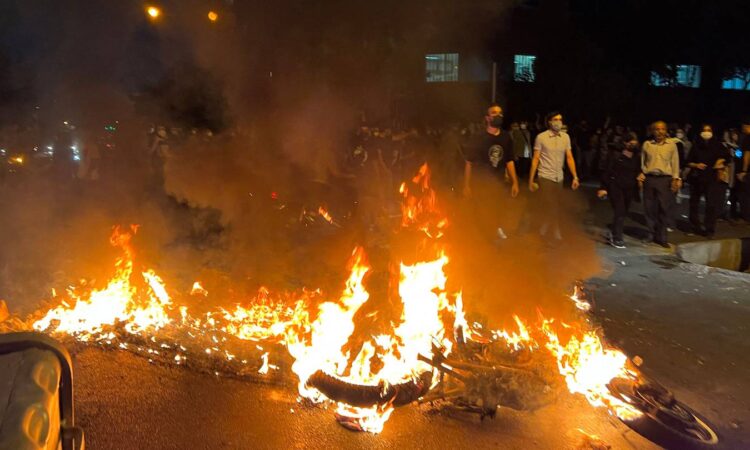
Iran’s troubled currency fell to a record low against the US dollar at the weekend as the country’s increasing isolation and possible European Union sanctions against the Islamic Revolutionary Guard Corps further knocks confidence.
The slide comes amid a mass protest movement that has rocked the country for four months with no signs of slowing down.
Ties between the EU and Tehran have deteriorated in recent months as efforts to revive nuclear talks have stalled. Iran has detained several European citizens and the bloc has become increasingly critical of the violent treatment of protesters and the use of executions.
The regime’s bloody crackdown on protesters has killed at least 481 people, according to the Oslo-based Iran Human Rights group, while the UN says at least 14,000 have been arrested. Four people have been executed in relation to the protests.
The EU is discussing a fourth round of sanctions against Iran and diplomatic sources have said members of the IRGC will be added to the bloc’s sanctions list next week. But some EU member states want to go further and classify the Guards as a terrorist organisation.
Iran has warned the EU against such a move.
The dollar was selling for as much as 447,000 rials on Iran’s unofficial market on Saturday, compared with 430,500 the previous day, according to the foreign exchange site Bonbast.com.
The rial has lost 29 per cent of its value since the outbreak of nationwide protests following the death in police custody of a 22-year-old Mahsa Amini on September 16.
The unrest has posed one of the biggest challenges to theocratic rule in Iran since the 1979 Islamic Revolution.
The economic Ecoiran website blamed the steady fall of the rial on an apparent “global consensus” against Iran.
“Increasing political pressures, such as placing the Revolutionary Guards on a list of terrorist organisations, and imposing restrictions on Iran-linked ships and oil tankers … are factors pointing to a global consensus against Iran, which may affect the dollar’s rate in Tehran,” Ecoiran said.
Experts warn that economic strain could spark more demonstrations.
“Now, with a dramatic loss of the value of the Iranian currency since the turn of year, economy-driven protests could be expected, which as the past shows could quickly turn political,” Ali Fathollah-Nejad, Iran expert with the American University of Beirut’s Issam Fares Institute for Public Policy and International Affairs, told AFP.
The European Parliament has called for the EU to designate the IRGC a terrorist group, blaming the powerful force for the repression of protesters and the supply of drones to Russia. The assembly cannot compel the EU to add the force to its list, but the text was a clear political message to Tehran.
Panama’s vessel registry, the world’s largest, has withdrawn its flag from 136 ships linked to Iran’s state oil company in the past four years, the country’s maritime authority said this week.
Iran’s central bank governor Mohammad Reza Farzin on Saturday blamed the fall of the rial on “psychological operations” which Tehran says its enemies are organising to destabilise the Islamic Republic.
“Today, the central bank faces no restrictions in terms of foreign currency and gold resources and reserves, and media deceit and psychological operations are the main factors behind the fluctuation in the free exchange rate,” state broadcaster Irib cited Mr Farzin as saying.
Facing an inflation rate of about 50 per cent, Iranians seeking havens for their savings have been trying to buy dollars, other hard currencies or gold.
While there have been fewer daily street protests since November when police stepped up heavy -handed tactics against demonstrators, the anger unleashed by Amini’s death in mid-September has not subsided.
Mass street protests continue in some regions and there have been tentative signs of division within the regime.
Experts believe that a new status quo could be setting in.
“With the number of protests diminishing since mid-November, it appears that a stalemate has set in, with neither the regime nor the protesters’ side being able to overwhelm the other,” said Mr Fathollah-Nejad.
“Despite the relative decline in the number of protests ever since, it is worth recalling that revolutionary processes usually entail phases of both relative calm and uproar.”
In the face of the challenge there has been little sign the leadership under Ayatollah Ali Khamenei is ready to offer meaningful concessions and it could yet ratchet up the repression.
Mr Khamenei this month appointed former Tehran police chief Ahmad Reza Radan as commander of the national police force. Mr Radan is a hardline figure seen as having played a key role in the suppression of the 2009 protests over disputed elections.
Updated: January 22, 2023, 8:46 AM



